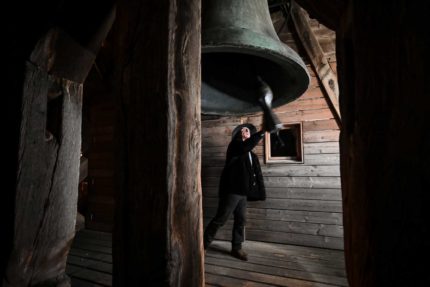For 615 years, Lausanne’s designated night watchman has called out the hour from the bell tower of Lausanne’s cathedral and assured the townspeople that all is well. From his watchtower atop the 153 stone steps of the cathedral belfry, he emerges every hour from 10PM to 2AM, cups his hands around his mouth and cries the hour to each cardinal direction: “This is the watchman! The bell has rung [whatever the hour is]!”
The tradition was established after a fire devastated the city in 1405. During the fire itself, the bells were rung continuously as calls to action. People rallied to put out the fire under their peals of encouragement. The night watchman was appointed to look over the city from the height of the bell tower and keep an eye out for any signs of smoke or fire, shouting the hour to check in and connect with a network of watchmen on the ground who could rapidly rouse the city in case of need.
The job continued unchanged until 1960 when the city trimmed the hours of the watchman to the current four from the original full night coverage of 9PM to dawn. The hourly ringing of the bells had been automated a decade earlier, fire alarms and sirens had been installed on buildings in 1907 fire emergencies were handled by professionals, and everyone had clocks and watches of their own to figure out the time.
The local press expressed concern that this change sounded the death knell, as it were, of the longstanding tradition and residents rallied to defend their beloved watch, showering the city government with letters demanding the night watchman remain on duty in perpetuity. Today the tradition continues undeterred, a proud holdover of the Middle Ages, a landmark symbol of the city’s history and community spirit. Lausanne is now one of only seven cities in Europe that have a night watchman on duty 365 days a year.
Since 2002, the watchman has been Renato Häusler. For nigh on two decades he has embraced his role for its connection to the city’s past, its significance as intangible cultural heritage and for the unique opportunity it affords him to experience the city at night from on high. Now that another peril is abroad in the land, the night watchman’s vigil has taken on new meaning. He shouts the hour and then he peals Clémence, the bell designated to sound in an emergency, swinging the clapper by hand. Three strikes followed by six strikes and again warn the people of danger.
The Cathedral of Notre Dame of Lausanne was built in the 13th century, but the oldest of the bells, Lombarde, dates to 1493. Clémence is the next in seniority, cast in 1518. With a diameter of 174 cm (5’8.5″) and weighing four tons, she is the second largest of the cathedral’s bells after the bourdon Marie-Madeleine. She rings a C note.
(The article erroneously states Clémence is made of steel. Like most of her kind, she’s made of bell metal, a high-tin bronze alloy that is more rigid and sonorous than regular bronze. The clapper is soft steel.)
The canton of Vaud of which Lausanne is the capital has the highest coronavirus rates in Switzerland. There is no stay at home order in place yet, but public gatherings of more than five people have been banned and the thriving night life that the watchman once watched over has gone silent, lending him fresh insight into what his predecessors experienced.
“Since these restrictive measures urging people to stay at home, it has completely changed,” said Hausler.
“It is quiet all week, even from 8:00pm, and when I get here, there is hardly any activity around the cathedral or even in the city so it brings a tranquility that I have never experienced before.
“There is a real calm which resembles what it would have been like in the past, before there was all this traffic noise.
“There is perhaps just one last thing that would bring us right back to how things were in the Middle Ages: turning out the lights.”
